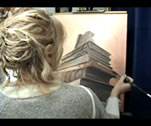This section provides a list of techniques, materials, and common references that are frequently used in the design and decorative painting profession.
Faking bamboo reflects the '50s and '60s period. It is an attractive decor for a small piece of furniture, a screen, and the inside of a cabinet or shelves. Since it is time consuming to complete, it is destined to small surfaces. It needs to be done with a water based glaze and fine brushes to achieve a refined and fresh look. Isabel O'Neil made splendid renderings of this modest plant.
These are used to create very fine and transparent glazes, ideal for imitating wood or marble, for instance. Nowadays, they are less popular with the availability of readymade acrylic glazes. Also, they need to be sealed with an oil-based finish that may yellow with time. You cannot use water borne varnish that would reactivate the glaze and smear your finish.
In order to whiten wood on a piece of furniture or a floor, sometimes bleach mixed with water is used. However the generic term "bleached" more often means whitened, faded or colorless. This look can be achieved through various possible methods, and, depending on the effect obtained, it will also be referred to as "pickled", "distressed" or "ceruse". The easiest way to proceed for a neophyte is to stain the wood to a medium dark shade, especially if it is new, followed by an application and vigorous rub of a very diluted coat of paint, similar to a wash. The bleach solution may reap wonderful results but you need to know the essence of the wood you are working with. The ensuing result will vary depending on the wood's color and grain density. And generally speaking, water is the enemy of wood! Ready mixed solutions are available from stores, but again, be wary of marring the wood. Bleached wood, truly tinted within the grain, offers a unique advantage: it is maintenance free: you will never have to repaint it or repair a ding to it.
Charles Andre Boulle was an eighteenth century French cabinet maker well known for his exceptional ebonized pieces of furniture, inlaid with a decor created mostly from brass, ivory and tortoise shell. His skills and taste were exceptional in the making of the furniture as well as in its design. Thousands of hours would be employed to complete each piece; the wood was darkened to an ebony shade with a view to enhance the gold from the brass and the red and yellow of the tortoise shell. The ornaments alone were carefully thought out and researched, to fit the proportions of the piece ideally. Many reproductions were made in the nineteen-century, with more or less serendipity. A manufactured production could not rival an artistic handmade creation. These ebonized furniture pieces are sought after for their sober lines that suit a well-appointed traditional interior as well as an ultra-modern space.
Several factors must be considered when buying brushes. The quality of a brush is of utmost importance; pulling on the hairs of your prospective brushes before purchasing will ensure that they will not detach onto your project and ruin it. This is the only valuable test, since many expensive brushes are as disappointing as cheap ones. Once you have sunken half your money into them, you need to neatly groom them after each job, which will add to their life expectancy. Another important factor is the type of brush to use. For oil painting, use only brushes with a natural bristle. Generally, you must carry thin and thick brushes, as well as firm and supple ones, depending on the medium used or the type of painting you are executing.
This is a very ornamental wood graining derived from an irregular growth of the tree. It differs drastically from the usual wood patterns defined by lines and pores. Burl displays small circles or mottled patterns; it can be stippled with dark dots or flamed with lighter shades. There are many varieties of burl. Because of its moderately rare occurrence it is expensive, and its veneer has been reserved to line interior of upright desks, embellish front or top panels of furniture or doors, to make precious boxes and so forth. It is not very difficult to reproduce burl effects; water borne glaze will be better suited to achieve a finer result. Less is more: you need to stay simple in the execution of the pattern and work quickly, avoiding a heavy rendition of it.






